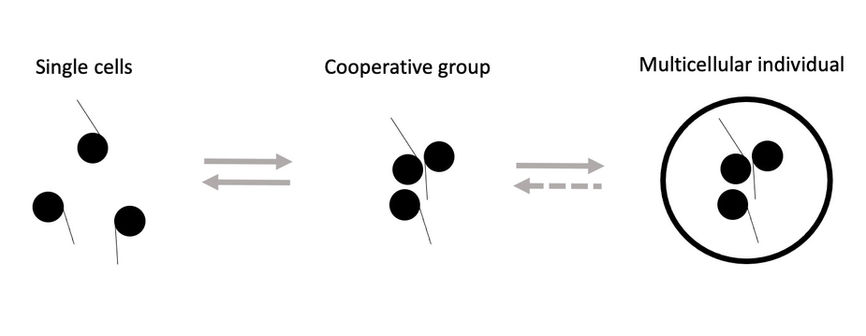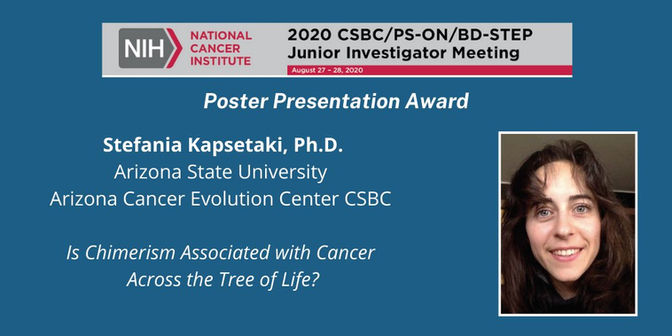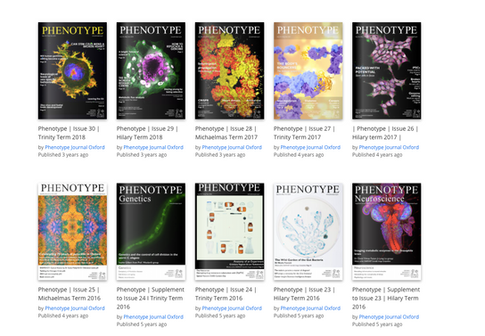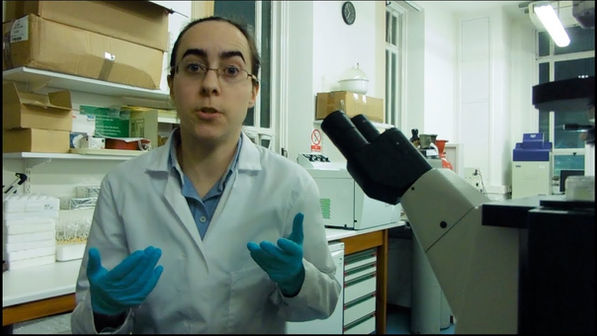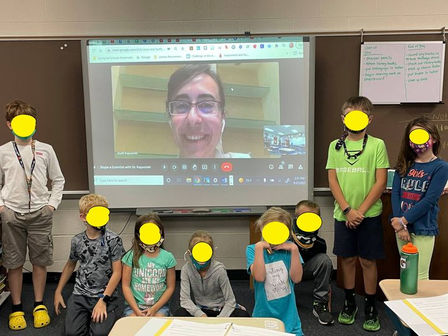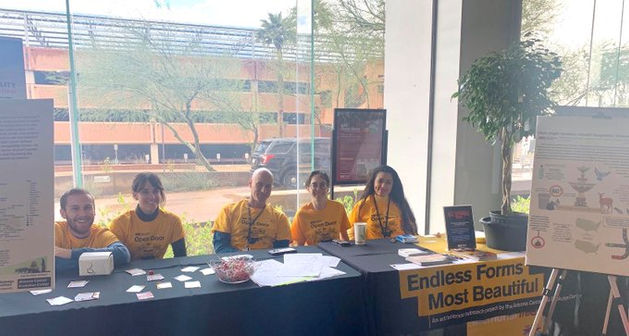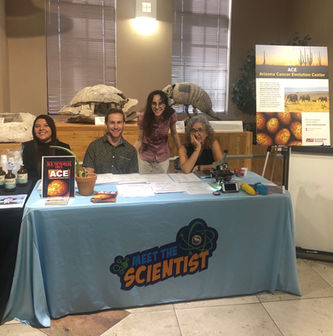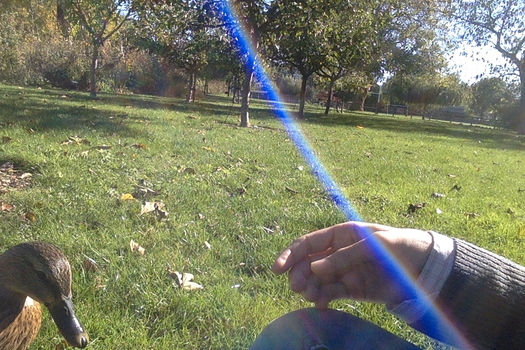Mou
Γεια μας (means "to our health" in Greek).
Everyone is an expert (in something) and a non-expert (in something else).
Here you'll find parts of my journey in science and the arts.
- Dr. Stefania Kapsetaki
Visiting Lecturer in Biology (Frederick University)
Postdoc in aging and autophagy (IMBB-FORTH)
MSc in science communication (Hellenic Open University)
Alumna:
Postdoc in bioelectricity, cooperation, aging, and immortality (Tufts University)
Postdoc on cancer across species (Arizona State Univeristy)
Tutor (University of Oxford)
MSc and PhD on the evolution of multicellularity (University of Oxford)
BSc in molecular biology and biotechnology (University of Crete)
Diploma and Ptyhio in Piano performance (Minoan School of Music)
Ptyhio in Music Theory (Minoan School of Music)
Welcome!
19. Mellon W.J., Sterner B., Agren A., Vincze O., Marx M.T., Kapsetaki S.E., Huang P.H., Yavari B., McCollum H.W., Horowitz B.N., Human H., Baciu C., Richker H., Mallo D., Maley C.C., Harmon L., Compton Z.T. Leveraging Comparative Phylogenetics for Evolutionary Medicine: Applications to Comparative Oncology. Evolution, Medicine, and Public Health (2025)
18. Kapsetaki S.E., Pimkina A., McMillen P., Tayyebi P., Erickson P., Levin M. The bioelectrics of immortality and mortality in cold-sensitive Hydra oligactis. Bioelectricity (2025)
17. Kapsetaki S.E., Basile A.J., Compton Z.T., Rupp S.M., Duke E.G., Boddy A.M., Harrison T.M., Sweazea K., Maley C.C. The relationship between diet, plasma glucose, and cancer prevalence across vertebrates. Nature communications (2025)
16. Seyedi S., Harris V., Kapsetaki S.E., Narayanan S., Saha D., Compton Z., Yousefi R., May A., Fakir E., Boddy A., Gerlinger M., Huijben S., Gouge D., Cisneros L., Ellsworth P., Maley C.C.. Resistance management for cancer: lessons from farmers. Cancer Research (2024)
15. Compton Z., Mellon W., Harris V., Rupp S., Mallo D., Kapsetaki S.E., Wilmot M., Kennington R., Noble K., Baciu C., Ramirez L., Peraza A., Martins B., Sudhakar S., Aksoy S., Furukawa G., Vincze O., Giraudeau M., Duke E.G., Spiro S., Flach E., Davidson H., Li C., Zehnder A., Graham T.A., Troan B., Harrison T.M., Tollis M., Schiffman J.D., Aktipis A., Abegglen L.M., Maley C.C., Boddy A.M. Cancer prevalence across vertebrates. Cancer Discovery (2024)
14. Kapsetaki S.E.*, Compton Z.T*., Mellon W., Vincze O., Giraudeau M., Harrison T., Abegglen L.M., Boddy A.M., Maley C.C., Schiffman J.D. Germline mutation rate predicts cancer mortality across 37 vertebrate species. Evolution, Medicine, and Public Health (2024)
13. Kapsetaki S.E.*, Compton Z.*, Dolan J.+, Harris V.K., Mellow W., Rupp S.M., Duke E.G., Harrison T.M., Aksoy S.+, Giraudeau M., Vincze O., McGraw K.J., Aktipis A., Tollis M., Boddy A.M., Maley C.C. Life history traits and cancer prevalence in birds. Evolution, Medicine, and Public Health (2024)
12. Kapsetaki S.E., Cisneros L.H., Maley C.C. Cell-in-cell phenomena across the tree of life. Scientific Reports (2024)
11. Kapsetaki S.E., Fortunato A., Compton Z., Rupp S.M., Nour Z.+, Riggs-Davis S.+, Stephenson D.+, Duke E.G., Boddy A.M., Harrison T.M., Maley C.C., Aktipis A. Is chimerism associated with cancer across the tree of life? PLOS ONE (2023)
10. Marquez Alcaraz G.*, Kapsetaki S.E.*, Whisner C.M., Aktipis A. On the hunt for cancer's microbial "party" in the animal kingdom. Frontiers for Young Minds (2023)
9. Kapsetaki S.E.*, Marquez Alcaraz G.*, Maley C.C., Whisner C.M., Aktipis A. Diet, microbes, and cancer across the tree of life: a systematic review. Current Nutrition Reports. (2022)
8. Seyedi S., Kapsetaki S.E., Maley C.C. Learning Science With the Hobbits. Ask A Biologist. (2022).
7. Kapsetaki S.E., Fisher R. Chapter 10: “Group formation: Hypotheses for the evolution of clonal multicellularity” in Herron MD, Conlin PL, and Ratcliff WC eds. book “The evolution of multicellularity”. Taylor and Francis Publishing. (2022). Link to chapter
6. Kapsetaki S.E., West S.A. The costs and benefits of multicellular group formation in algae. Evolution. 73.6 (2019): 1296-1308.
5. Kapsetaki S.E., Fisher R.M., West S.A. Green blobs and predatory beasts: clues to multicellularity. Frontiers for Young Minds. 7:20. (2019).
4. Kapsetaki S.E., Tep A.+, West S.A. How do algae form multicellular groups? Evolutionary Ecology Research. 18.6 (2017): 663-675.
3. Kapsetaki S.E., Fisher R.M., West S.A. Predation and the formation of multicellular groups in algae. Evolutionary Ecology Research. 17.5 (2016): 651-669.
2. Kapsetaki S.E.*+, Tzelepis I.*+, Livadaras I., Garantonakis N., Varikou K., Apidianakis Y. The bacterial metabolite 2-aminoacetophenone promotes association of pathogenic bacteria with flies. Nature Communications 5.1 (2014): 1-7.
1. Tzelepis I.+, Kapsetaki S.E.+, Panayidou S., Apidianakis Y. Drosophila melanogaster: a first step and a stepping-stone to anti-infectives. Current Opinion in Pharmacology, (2013) 13:1–6.
Preprints
2. Kapsetaki S.E., Seyedi S., Compton Z., Rupp S.M., Duke E.G., Schiffmann J.D., Troan B.V., Harrison T.M., Maley C.C., Abegglen L., Boddy A.M. Immune-cancer analyses across mammals reveal a potential trophic level and platelet-linked tradeoff between cancer and trauma mortality. bioRxiv (2025)
1. Kapsetaki S.E., Compton Z., Rupp S.M., Duke E.G., Boddy A.M., Garner M.M., Harrison T.M., Aktipis A., Maley C.C. The ecology of cancer prevalence across species: Cancer prevalence is highest in desert species and high trophic levels. bioRxiv (2022)
Theses
3. Kapsetaki S.E., Multicellular group formation in algae, Oxford University Research Archive. (2019).
2. Kapsetaki S.E., Predation and the evolution of multicellularity, Oxford University Research Archive. (2015)
1. Kapsetaki S.E.+, Assessing the antibiotics Carbenicillin, Ciprofloxacin, Ticarcillin and Kanamycin on the model organism Drosophila melanogaster for combinatorial antimicrobial effect against the bacterium Pseudomonas aeruginosa, University of Crete Library. (2013), Thesis grade: 10/10
Undergraduate student+ Corresponding author Co-first author*
Within without
Energy RGB
Freedom or death. The graves of '21
hand project_fusio
multiverse
Geometries
Plant cells with stomata
microscope light
Reflections
Scenery
Sea
The painter_1
Timeless time
Zoom
Δόγμα και δοκιμασία_Dogma and deviant
Δοκιμές_Trials
Σχεδια δίχως τόνο
My universe
Chasing the Coronavirus
party strings
εξερευνήσεις_1
Ποικιλία νόμων ενώνει η αγάπη_2
ο Θεός να βάλει το χέρι του_A helping hand
το DNA είμεθα
bubbling_2
Colours
The painter_2
εξερευνήσεις_2
Ποικιλία νόμων ενώνει η αγάπη_3
Ό,τι δομείς
bubbling_1
bubbling_3
Fusio
bubbling_4
Ποικιλία νόμων ενώνει η αγάπη_1
Ποικιλία νόμων ενώνει η αγάπη_4
Ο δρόμος συγκέντρωσης όταν μας κυνηγάνε τα πάντα
Διάσωση_1
Διάσωση_2
Διάσωση_3
Διαπίστωση_1
Διαπίστωση_2
o πολυδιάστατος άνθρωπος
στα χωράφια
μνήμες σχημάτων Gestalt, τα διαφορετικά παραδείγματα κατανόησης της πραγματικότητας όπως ανέφερε ο Thomas Kuhn.
Η πραγματικότητα είναι μία. Τα παραδείγματα πολλά.
παραλλαγές της Άνοιξης_1
παραλλαγές της Άνοιξης_4
ο κήπος μου_2
το δέντρο
συννεφιασμένος μινώταυρος_1
παραλλαγές της Άνοιξης_2
αποπροσανατολισμένη αγέλη
ανεμώνα
αόρατο
συννεφιασμένος μινώταυρος_2
παραλλαγές της Άνοιξης_3
ο κήπος μου_1
chem
Click to purchase selected digital artwork without the watermark
-
Featured in the New College Arts Anthology 2023, Oxford
-
Artwork on display at Michigan State University, SciComm, 2022
-
Artwork on display at the Arizona State University Health Medical Centre, Tempe, Nov. 2nd 2021–Nov. 30th 2022
-
Artwork on display at Michigan State University, SciComm, 2021
-
Featured in the New College Arts Anthology 2021, Oxford
Through art, I appreciate that every field is a struggle. Things don’t come easy.
One has to dig deep to realise One thing I know, that I don’t know a thing (Plato).
- Stefania -
- Biggest fear? Not waking up to the sirens.
- εκεί που δεν πατώ ειν το μονοπάτι
- συγκέντρωση: λακκούβα απ’όπου δύσκολα βγαίνεις
- “If an experiment does not hold out the possibility of causing one to revise one’s views, it is hard to see why it should be done at all” -Peter Medawar from his book "Advice to a Young Scientist"
- Ο καθρέπτης είναι έργο τέχνης;
- Κόκκο κόκκο χτίσαμε το «εν οίδα ότι ουδέν οίδα»
- Ένα έργο διαχρονικό βρίσκεται ποτέ εδώ; Αποθήκευση. Φωτογραφία. Βίντεο. Γραφή. Γιατί να προσέξω το τώρα, αφού είναι γραμμένο για να το δω; Ζω ποτέ το τώρα;
- Έχουν αξία και αυτά που δεν έχουν εμφάνιση.
- What words can one invent to describe a picture?
- The value of science varies. Sometimes you have to put sweets on the table for people to come and listen to science. Other times, you don’t have to.
- Καμία φορά ονειρεύομαι. Ότι βρίσκομαι σε άλλο κόσμο. Ειν’οι μνήμες;
- 2020. Κλείνουν σχολεία. Κορώνα γράμματα;
- Reality is what you look at.
-
Honorary Certificate at the1st National Poetry Competition “Kefalos” (2019)
-
Honorary Certificate at National Poetry Competition “Dimophelia” (2017)
-
Qualification to the final round of the International Poetry Competition, Delfi, Greece (2017)
The book covers are drawings/photos from my collection "μη μου τους κύκλους τάραττε".
Through poetry, I gradually realise the value and depth of every single word, gap,
comma, and full stop. Every single signal, as illustrated in Bob Dylan’s Blowin’ in the wind
- Stefania -
Email: stefania.kapsetaki@tufts.edu

